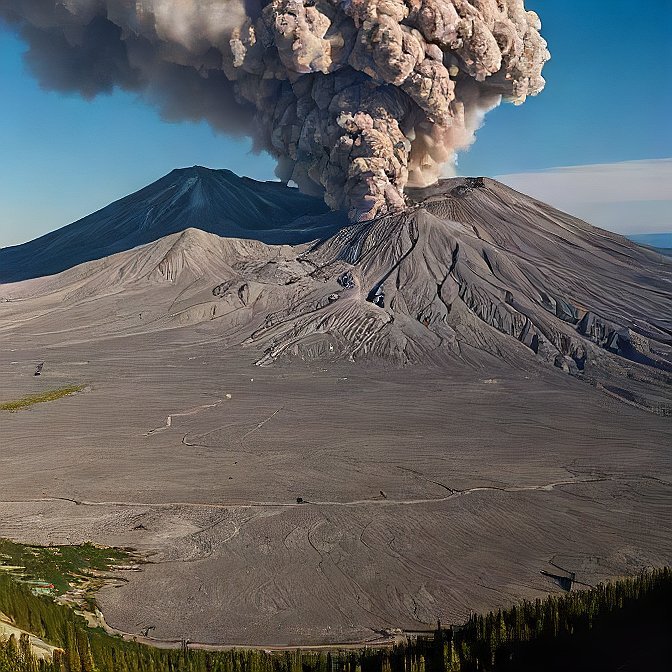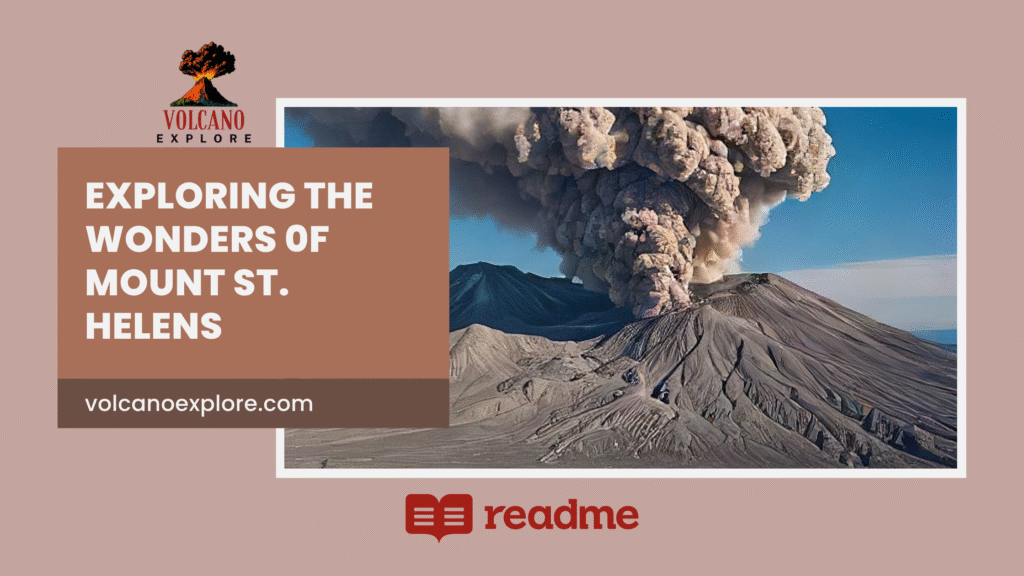Table of Contents
Introduction

People visit and observe Mount St. Helens, which rose to volcanic status during the 1980 eruption, to study and watch the peak and vacation as students of the natural world. Natural wonder, together with important geological elements, made Mount St. Helens an essential destination that attracts visitors who want to witness the authority of raw natural forces. Inside the Washington Cascades, the volcanic mountain Mount St. Helens welcomes recreational opportunities that fulfill diverse exploration needs. This awe-inspiring natural geological formation generates everlasting experiences which appeal to every recreational group, including hiking enthusiasts and nature enthusiasts, and sunseekers throughout their lives.
What is Mount St. Helens?
The volcanic structure of Mount St. Helens operates as a stratovolcano, which produces regular explosive volcanic phenomena. A single explosive event launched on May 18, 1980, completely transformed every part of the surrounding area through powerful force. The 1980 volcanic event earns its position as one of America’s top volcanic disasters by wiping out many people and massive regions of wooded land. Public access and scientific observation take place at the Mount St. Helens National Volcanic Monument to analyze wildlife behavior following the eruption and ongoing ecosystem recovery.
Travelers worldwide can access this prime destination starting from base level 2,550 meters (8,363 feet) at a distance of 155 kilometers (96 miles) south of Seattle. The research conducted by scientists at Mount St. Helens yields both essential understanding about volcanic events and evidence about how ecosystems recover after volcanism and the ways Earth’s geology develops on a planetary scale.
Why Visit Mount St. Helens?
Mount St. Helens must be visited by multiple significant reasons. Fully captivating surroundings at the monument draw in most of its visitors. Visitors see the volcanic province which has turned barren through the eruption yet stands against the thriving forest habitat. A variety of ecological elements inhabit the monument territory which includes volcanic rocks paired with forests and wetlands and clear lakes among others.
Guests need to witness research activities performed on the volcanic site. Scientists studied both environmental and human effects of destructive events after the 1980 volcanic eruption provided them with investigation opportunities. Visitors who observe the volcano region continuously now benefit from accessing multiple museums as well as observatories and visitor centers to find information about volcano past and present behavior.
Mount St. Helens welcomes visitors who want outdoor adventures while visiting the site. Guests can discover appropriate leisure pursuits among hiking and wildlife nature viewing while driving and taking photographs all through Mount St. Helens. Customers experience adventure due to the area’s unique geography which enables them to inspect rough terrain through walking or driving procedures.
Curious for more? Dive into our other exciting blogs!
Best Activities to Do at Mount St. Helens

Hiking Trails
The multiple hiking routes of Mount St. Helens serve as the most efficient method to witness its primitive scenic magnificence. Different hiking trails at Mount St. Helens showcase remarkable sights of its crater in addition to pointing out the progress made since the volcanic event.
Travelers who want to observe underground lava tubes commonly choose to visit the Ape Cave. Excursions are available for tourists to visit this 2.5-mile-long lava tube which represents one of the longest underground features within North America. Guests can understand volcanic formation processes and discover the dark and chilly cavern while learning about volcanic cavity development at the Ape Cave.
People seeking high-risk outdoor adventure can visit Johnston Ridge Observatory for an all-encompassing view of the volcano combined with its regional terrain. Hikers can reach a breathtaking panorama of Mount Saint Helens crater along with Spirit Lake through a 5-mile Harry’s Ridge Trail that features a moderate hiking difficulty. Hikers will experience breathtaking prospects while traversing this path because dramatic lighting effects create strong shadows on the volcano’s slopes during sunrise and sunset.
Volcano Tours
Guided volcano tours serve as an excellent learning experience for those wanting to understand Mount St. Helens’ past explosive behavior. The local tourism companies run educational trips to the primary sites located near the mountain. Reliable guides share comprehensive details regarding the 1980 volcanic eruption together with its aftermath and up-to-date geologic assessments. Visitors studying the local vegetation and animals will discover how the environment has been recovering through time after the volcanic eruption.
The Johnston Ridge Observatory presents visitors with an educational film about the volcanic eruption and its aftermath which also features science-based displays about volcanic operations. The premises feature both a gift shop and a café area for visitors to find refreshment and admire the scenery.
Wildlife Watching
The vast wildlife population in the Mount St. Helens region attracts nature enthusiasts alongside photographers who visit this region often. Since the volcanic eruption the area has regenerated to support numerous animal species starting from elk and deer and including occasional sightings of cougars and black bears.
The area offers an attractive habitat for birdwatchers who commonly spot bald eagles flying above the lake while resting on nearby trees close to the volcano. Dense forests keep many songbirds, along with owls and woodpeckers, as residents, while the waterfowl choose to live in the nearby rivers and lakes.
Scenic Drives
Several roads throughout the area allow visitors to discover panoramic views of Mount St. Helens and its surrounding countryside in their automobile. The Spirit Lake Memorial Highway stands as a favorite route because it leads travelers through beautiful forest areas while showing spectacular views of the mountain and passing several lakes. You can find many pull-offs and viewpoints in addition to parking areas that let you admire the landscape along the highway.
Photography
Mount St. Helens remains an optimal spot for photographers because its dramatic landscapes combine with an environment that changes every day. The area affected by the eruption stands out as charred ground while forest vegetation continues to thrive around it which generates an eye-catching dispute. Photographers find endless possibilities to capture stunning images regardless of their interest in the crater or native animals or fantastic views seen from different observation points at Mount St. Helens.
Best Time to Visit Mount St. Helens
When planning your visit to Mount St. Helens, you should check which activities draw your interest, as it changes which period is optimal. People who want to trek through the mountains should visit during summer, between June and September. The dry and pleasant conditions prevail throughout the year, making all paths accessible to visitors. While this is the period of maximum visitor traffic, the most sought-after destinations will have substantial crowds.
The best period for vacationing without crowds occurs in May through early October at Mount St. Helens. The mountain features agreeable local weather during this time but you can expect less density of visitors at both paths and observatories. During fall you will find an additional benefit of remarkable fall foliage that creates visually stunning forest landscapes.
The winter months from November through March bring cold weather with snow accumulation, yet provide visitors with minimal crowds at the site. The trails remain inaccessible because of snow and ice accumulation, but snowshoeing together with winter photography proves to be a satisfying activity. Due to snow conditions, you must verify road safety beforehand because certain paths may remain blocked off to vehicles.
Where to Stay Near Mount St. Helens
Tourists visiting Mount St. Helens have numerous place to stay which spans from basic campgrounds to comfortable cabin facilities as well as hotel accommodations. You can find comfortable hotel accommodations at both Castle Rock and Toutle which provide lodgings for people who wish to relax following their outdoor activities.
Multiple campgrounds in the location offer an authentic outdoor experience to visitors alongside Seaquest State Park and Coldwater Lake Campground. Although campgrounds let you reach hiking trails easily you can still enjoy the beauty surrounding you.
A more luxurious vacation experience can be found when you book one of the available cabins or lodges at Mount St. Helens Lodge or Silver Lake Resort. Staying in these resorts allows travelers to watch the majestic volcano in addition to finding serenity before and after spending time exploring.
Safety Tips for Visiting Mount St. Helens

The Mount St. Helens attraction demands safety awareness from all visitors who explore its region. Check available volcanic activity reports before traveling to confirm that active hazards do not exist on the mountain. Every trip to Mount St. Helens should include both trail restrictions and complete adherence to local authority directions. The environment leading to the volcano has uneven ground and unsteady weather patterns that occur frequently.
Prepare for hiking and outdoor exploration by carrying enough water together with sturdy footwear and layer-based clothing in your gear. Hikers must prepare physically because the trails in proximity to the summit present demanding conditions. The map together with a first-aid kit along with a GPS device should always travel with you.
Conclusion
Every visitor will find unique attractions in this one-of-a-kind destination known as Mount St. Helens. The destination welcomes visitors who enjoy exploring nature or history as well as those seeking adventure activities, since it provides a wide selection of experiences for everyone. Visitors will never forget exploring Mount Saint Helens because it offers trail hiking in addition to portraying its volcanic history. Visitors who want to witness how nature operates can find their perfect destination in this site because it provides stunning natural landscapes as well as scientific wonders, together with lots of outdoor recreation activities.
For more info about volcanoes: Click Here.
FAQs
Is Mount St. Helens safe to visit?
Visitors searching for safe conditions regarding the area will find them at St. Helens. A review of the active nature of Mount St. Helens forms the necessary first step for all visitors because local guidelines require their adherence. The authorized walking paths provide the only acceptable means of travel, while visitors need to be aware of sudden weather shifts.
Can I hike to the summit of Mount St. Helens?
Men and women who aim to climb Mount St. Helens need hiking permits and physical training since hiking demands strenuous conditions. People interested in visiting the summit under organized educational conditions can sign up for tour programs.
What is the best time of year to visit Mount St. Helens?
The period from June through September stands as the top window to check trail accessibility at Mount St. Helens. The natural environment at Mount St. Helens offers visitors serene experiences as well as fantastic scenic views when the tourist crowds remain low during the spring and fall seasons.





